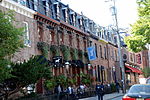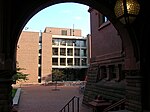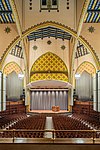Van Pelt Library

The Charles Patterson Van Pelt Library (also known as the Van Pelt-Dietrich Library Center, and simply Van Pelt) is the primary library at the University of Pennsylvania. The building was designed by architects Harbeson, Hough, Livingston & Larson, and built in 1962. It has a gross area of 201,215 square feet (18,693 m2). In addition to being the primary library on campus for social sciences and humanities, it also houses the Lippincott Library of The Wharton School, the Ormandy Music Library, and the Kislak Center for Special Collections, Rare Books and Manuscripts. Van Pelt houses strong Area Studies collections in African, Japanese, Latin American, Chinese, Middle East, South Asia, and Judaica & Ancient Near East Studies. The Henry Charles Lea Library is located on the 6th floor of Van Pelt Library. The library holds the Weigle Information Commons, located on the west side of the 1st floor. Vaguely Grecian with a massive colonnade, but screened by brick panels with small windows that resemble an old French library, the Van Pelt Library is a major presence on the campus. A large modern art sculpture, called The Button, sits at its southern entrance.
Excerpt from the Wikipedia article Van Pelt Library (License: CC BY-SA 3.0, Authors, Images).Van Pelt Library
Grays Ferry Bridge Path, Philadelphia South Philadelphia
Geographical coordinates (GPS) Address Nearby Places Show on map
Geographical coordinates (GPS)
| Latitude | Longitude |
|---|---|
| N 39.9527 ° | E -75.1936 ° |
Address
University of Pennsylvania
Grays Ferry Bridge Path
19104 Philadelphia, South Philadelphia
Pennsylvania, United States
Open on Google Maps








